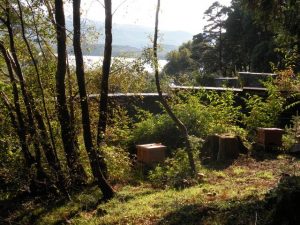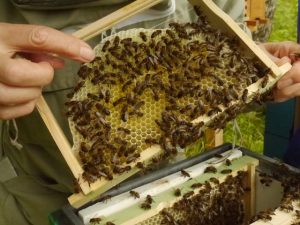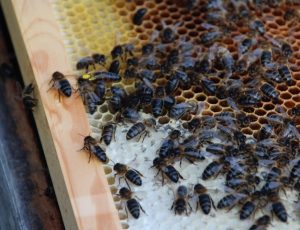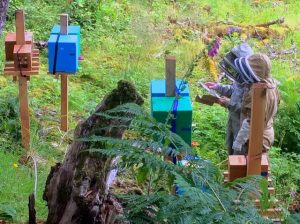Ardnamurchan Native Bee Breeding Project

Ardnamurchan Project – a cautionary tale
Beware siting colonies in marginal areas
Beekeepers keen to contribute to the conservation and availability of Apis mellifera mellifera and a fairly remote local peninsula offering the strong likelihood of pure mating of honey bees combined to prompt the start of the Ardnamurchan Native Bee Breeding Project. Managed by members of the Sunart, Moidart, Morvern and Ardnamurchan Beekeepers (SAMMBA) the first queens were received from Andrew Abrahams’ black bee reserve on Colonsay in 2014, with two further batches of queens in 2015 and 2016.
Based in Glenborrodale, about mid-way along the 23-mile long peninsula, we were offered fine south-facing apiary sites by the Ardnamurchan Estate and owners of Glenborrodale Nursery. The mating apiary is partly shaded by trees (though overheating is too rare a problem in the wild west!) and it too is beautifully set in this majestic landscape.
Our intention was to conserve stocks of the sub-species and, we hoped, provide Amm queens to others around Scotland. Initial funding was provided by BIBBA and, later, we were awarded Scottish Heritage Lottery Funds. So we were able to buy Swienty polystyrene hives for the colonies. In the mating apiary we use both Apideas and Lyson MiniPlus mating nucs. These are set on wooden stands made of locally-felled Douglas fir, skilfully made by a beekeeper member (see photo).
Given the area has poor fertility and few gardens, we always planned to run a relatively small number of colonies: 10 by Summer 2017. However, our plans were shown to be misguided.
Our experience through two notoriously poor Summers of 2015 and 2016 was difficult. Low temperatures and rain led to the bees resisting drawing queen cells and there were very few good queen-mating days. The area is on the edge of the honey bee’s natural habitat (even for this hardy sub-species) because of its high rainfall. The rain reduces flying hours and therefore income to the hives. No wild honey bees were known in Glenborrodale before the project was started, though bees had been kept there some years ago.
The colonies were not looking strong in late Summer 2016 and our worst fears were borne out. One colony dwindled and was robbed out in September; two were found to have failed in February and on closer examination, late in March, only one colony was of viable strength.
What had gone wrong? We found no signs of disease; varroa had been kept at low levels; there was apparently no acarine or nosema; there was no drone laying or lack of stores/fondant; bees managed in the same way in Acharacle and Strontian, further east, were all thriving.
With hindsight, we have concluded that Glenborrodale simply lacks enough forage – pollen in particular – to support the bees, or honey bees in any number. Spring forage may be adequate but there is little forage available after July and in both the poor Summers of 2015 and 2016, the most consistent flying weather was late in the season.
Clearly we had failed to assess the forage potential carefully enough. Yet I hope that our mistakes will serve as a valuable caution for others inclined to site hives in marginal areas.
Meanwhile Glenborrodale remains a potentially valuable mating site and we may continue to run the mating apiary, but we will no longer site colonies there throughout the year.



Kate Atchley
Ardnamurchan Project
